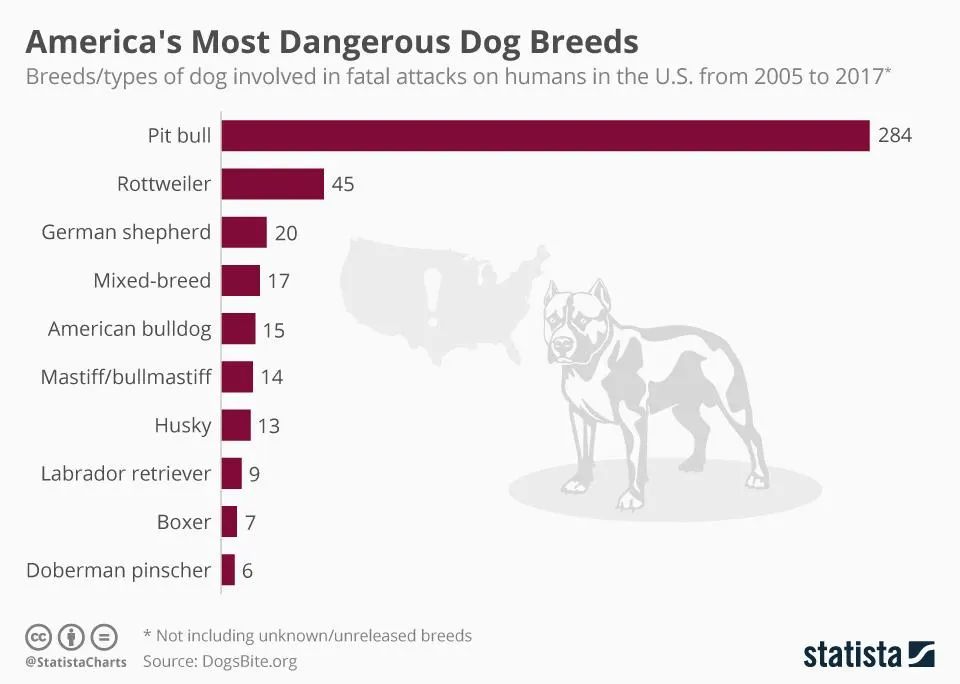Introduction
Cats and dogs are America’s favorite pets – experts estimate there are approximately 86.4 million pet cats and 78.2 million pet dogs owned in the United States. While our furry friends provide companionship and enjoyment, they can occasionally injure people through bites and scratches.
Both dog and cat bites can become infected and lead to serious medical complications. However, when it comes to mortality, dogs are statistically more dangerous – causing the large majority of pet-related deaths from bites and maulings.
This article provides an in-depth, data-based comparison of bites and fatalities from dogs versus cats. We examine key statistics, factors involved, and expert perspectives on mitigating risks for both pets and owners.
Dog Bite Statistics
Dog bites are very common in the United States and affect millions of people each year. According to the Centers for Disease Control and Prevention (CDC), dogs bite 4.5 million people annually in the United States. Almost 1 in 5 people bitten by dogs requires medical attention. Over half of all dog bite victims are children under the age of 12. While dog bites can happen anywhere, close to 80% occur on or near the victim’s property. Fatal dog bites are extremely rare, making up only 0.0002% of total dog bites. About 60% of fatal dog attacks involve dogs unrestrained on the owner’s property.
Dog Bite Fatalities
Despite some public perceptions, dogs actually cause very few human deaths per year. According to research studies, there are only about 30-50 fatal dog attacks reported annually in the United States. This means less than one in a million people die from dog bites each year.

Of these fatal dog bites, over 60% involve pit bulls or Rottweilers. These breeds were bred to be physically strong with a high prey drive, making them more likely to inflict severe injuries or death compared to other breeds. However, even for notoriously “aggressive” breeds, fatal attacks are extremely rare occurrences on a percentage basis.
Children under the age of 10 are the most common victims of fatal dog maulings, usually from family pets or dogs known to the family. Infants left unsupervised with dogs are especially vulnerable. While any breed is capable of killing a child or infant, larger dog breeds like pit bulls are responsible for most of these tragic incidents.
In addition to young children, the elderly are also disproportionately affected, often due to weaker defenses, slower reactions, and inability to fight off an attack. Overall, those most at risk are people who cannot adequately defend or protect themselves from a determined, powerful dog.
Factors in Dog Bites
Certain dog breeds are more likely to bite or attack than others. This is often due to genetics and instinct, rather than poor training or socialization. Some high risk breeds include pit bulls, rottweilers, German shepherds, huskies, Alaskan malamutes, doberman pinschers, and chows. These dogs were historically bred for protection, guarding, and fighting, and tend to be more territorial, powerful, and reactive.
However, any dog can bite if provoked or threatened, regardless of breed. Common circumstances that provoke dog bites include invading a dog’s territory, interacting with a dog that is sleeping, injured, sick, or protecting puppies, startling or cornering a fearful dog, abusive training methods, and interrupting dogs that are fighting or playing roughly. Children are most often bitten because they do not recognize warning signs like growling or tense body language. Dogs may also bite due to illness, trauma, or pain that causes them to lash out defensively.
Cat Scratch/Bite Statistics
Cats frequently use their claws and teeth defensively or playfully. Data from emergency rooms in the United States indicate approximately 400,000 cat bites occur each year. Additionally, an estimated 210,000 people seek medical care annually for cat bites, scratches or other trauma caused by cats. Children are most commonly the victims.
Studies show that cat bites are likely to become infected. One study found that over 30% of bite wounds became infected and required antibiotics. Another analysis reported that 75% of cat bites on the hand resulted in infection. The puncture-type wounds inflicted by cats provide ideal conditions for bacterial growth.
Common bacteria involved in cat bite infections include Pasteurella, Streptococcus, Staphylococcus and Moraxella. Cat scratches can also cause a variety of bacterial infections. Complications may include joint infections, meningitis, endocarditis and abscesses that require surgery. However, most cat scratches do not result in infection if properly cleaned.
Cat-Related Infections in Humans
Cats can transmit a number of diseases and infections to humans, some of which can be quite serious or even fatal in rare cases. Here are some of the main infections that can pass from cats to humans:
Cat Scratch Disease: This bacterial infection is transmitted through bites and scratches. Symptoms include swollen lymph nodes, fever, and fatigue. It usually resolves on its own, but antibiotics may be needed in some cases.

Ringworm: A fungal infection that causes ring-shaped skin lesions. Cats are common carriers. Ringworm is highly contagious but treatable with antifungal medications.
Toxoplasmosis: A parasite infection transmitted through exposure to infected cat feces. It is especially dangerous for pregnant women as it can cause birth defects. Healthy adults may have no symptoms.
Campylobacteriosis: Bacterial infection that causes diarrhea, cramping, fever, and vomiting. Usually foodborne but can also spread through contact with cat saliva and feces. Requires antibiotics for treatment.
Cat Scratch Fever: A bacterial disease with symptoms similar to the flu. Usually resolves on its own but can become serious. Spread through bites and scratches.
Comparing Mortality Rates
When directly comparing the number of human deaths caused by dogs versus cats, studies consistently show dogs are responsible for more fatalities each year. According to the Centers for Disease Control and Prevention (CDC), dogs were responsible for an average of 30-50 deaths per year between 1979 and 1998 in the United States. In contrast, fatalities directly caused by cats are very rare. One literature review found less than 10 documented deaths due to cat bites or scratches in the medical literature since 1988.
There are likely multiple reasons for this stark difference in mortality rates:
- Dog attacks are more likely to cause severe injuries and trauma given their larger size and strength compared to cats.
- Dog bites are more prone to becoming infected due to the bacteria present in their mouths.
- Dog breeds bred for aggression, such as pit bulls, may be more likely to be involved in fatal attacks.
- Dogs are more likely to attack vital areas of the body such as the neck and throat.
While cats may infect humans with bacteria leading to illness, dogs are more likely to cause immediate fatal damage during an attack. However, it should be noted that the overall risk of death from either animal is still extremely low, and proper training and supervision can prevent most attacks.
Mitigation Strategies
There are several ways to minimize the risk of bites and scratches from dogs and cats in order to protect both humans and pets.
For dogs, it’s important to socialize them from an early age to get them comfortable around people and other animals. Obedience training can also teach dogs proper manners and impulse control. Dogs should be carefully supervised around children, and taught not to bite or nip even when playing.

Using a leash in public areas, securing gates/fences around a yard, and crating a dog when guests are over are other ways to prevent opportunities for biting. Dogs may bite when scared or startled, so move calmly around them. Also avoid disturbing a dog when they are sleeping or eating.
With cats, provide appropriate toys and scratching posts so they don’t use their claws on people. Trimming their nails regularly can reduce scratches if they do jump on humans. Children should be taught safe ways to interact with cats to avoid getting scratched or bitten.
Carefully introducing cats to new environments and other pets can help minimize stress that may cause aggressive behavior. Providing vertical space via cat trees and perches gives cats an escape if they feel cornered or overwhelmed. Using pheromone diffusers may also curb anxiety and aggression in some cats.
Ultimately it comes down to understanding canine and feline body language, providing proper training and enrichment, and supervising all interactions, especially with children. This allows both pets and humans to coexist happily and safely.
Expert Opinions
Animal experts have weighed in on the relative risks posed by dogs versus cats:
“Both dogs and cats have the potential to harm humans, but fatal attacks are exceptionally rare,” said Dr. Beth Collins, a veterinarian specializing in animal behavior. “Dogs tend to cause more frequent bite injuries simply because their jaws are larger and more powerful. However, cats can transmit infections through scratches, which need to be taken seriously.”
“There’s no simple answer to which species harms more people,” explained Sarah Watson, an animal trainer and behaviorist. “A lot depends on the individual animal, its history, and how it has been raised and socialized around humans and other animals. With proper training and supervision for both dogs and cats, any risks can be minimized.”
“I advise my clients to observe caution around both unfamiliar dogs and cats,” said Dr. Mark Richardson, a veterinarian. “Never make assumptions about an animal’s behavior based solely on its species. Pay close attention to an animal’s body language and signals to avoid situations that could lead to injury.”
While perspectives differ, experts agree education, responsible ownership, and respect for animals can go a long way in reducing risks. Proper veterinary care, spaying/neutering, positive reinforcement training, and socialization are key for dogs and cats living harmoniously alongside humans.
Conclusion

In summary, while dog bites are more common and pose a higher risk of mortality for humans, infections transmitted from cats also contribute to deaths each year. The CDC confirms that dogs are responsible for the majority of bite fatalities in the U.S., with 20-30 deaths per year attributed to them. However, cats transmit diseases like rabies, plague and cat scratch fever, which cumulatively lead to thousands of deaths worldwide annually. Both pets require precautions like supervision, training, neutering and proper socialization to mitigate risks. Ultimately, the data indicates that dogs pose a higher direct mortality risk from bites and attacks. However, the public health impact of diseases transmitted by cats is also significant. Pet owners should take measures to prevent bites and scratches for both types of animals. More research is needed to quantify the relative risks for accurate comparison.
